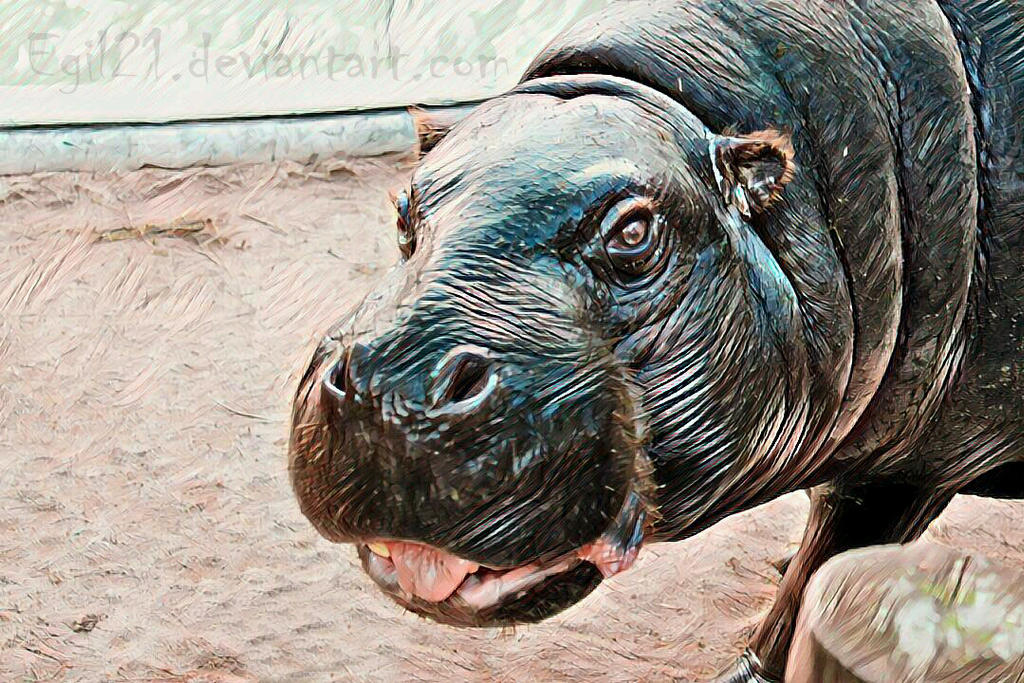ShopDreamUp AI ArtDreamUp
Deviation Actions
Description
Hipopótamo-pigmeu www.zoo.pt/site/animais_detalh…
Choroepsis liberiensis
Ordem: Cetartiodactyla Família: Hippopotamidae
É muito semelhante ao Hipopótamo comum, mas tem proporcionalmente a cabeça menor e os membros mais compridos. A coloração da pele é mais escura, variando entre o cinzento e o castanho-escuro. Os 4 dedos também estão unidos por membranas. Os caninos inferiores são longos.
Tem hábitos mais noturnos e é menos aquático e menos agressivo do que o Hipopótamo comum. Em caso de ameaça, tende a refugiar-se na água. Alimenta-se de folhas, rebentos, frutos e tubérculos. Tem o hábito de dispersar as fezes, num movimento giratório da cauda que permite aumentar a superfície coberta, uma vez que estas também servem como forma de marcação territorial.
Não existe uma época de reprodução definida. Os pares formam-se apenas para acasalar, sendo que a fêmea está recetiva à cópula apenas durante 24-48h em cada ciclo. A cópula pode ser em terra ou na água. A cria nasce em terra com cerca de 5 kg e é capaz de nadar pouco depois do nascimento.
Distribuição e Habitat: África Ocidental - Florestas densas alagadas das zonas baixas.
Conservação:Em perigo - O seu habitat sofreu mudanças drásticas nos últimos 30 anos. A população sobrevivente está muito ameaçada pela desflorestação devido à indústria madeireira e ocupação humana, pela caça intensa e conflitos armados locais.
Pygmy Hippopotamus
It is very similar to the common Hippopotamus, but has proportionally smaller head and longer limbs. The colour of the skin is darker, ranging from gray to dark brown. The 4 fingers are also joined by membranes. The lower canines are long.
It has more nocturnal habits and is less aquatic and less aggressive than the common Hippopotamus. In case of threat, it tends to take refuge in the water. It feeds on leaves, shoots, fruits and tubers. It has the habit of dispersing the faeces, in a rotating movement of the tail that allows to increase the covered surface, since these also serve as form of territorial marking.
There is no definite breeding season. The pairs are formed only to mate, and the female is receptive to intercourse only for 24-48h in each cycle. Copulation can be on land or in water. The baby of about 5 kg is born on land and is able to swim shortly after birth.
Distribution and Habitat: West Africa - Dense flooded lowland forests.
Conservation: Endangered - Its habitat has undergone drastic changes in the last 30 years. The surviving population is greatly threatened by deforestation due to logging and human occupation, by intense hunting and local armed conflicts.
Work produced from my original photos (visit to Lisbon Zoo).
:origin()/pre00/a622/th/pre/i/2018/076/8/d/animalia___chita_by_egil21-dc66f5y.jpg)
:origin()/pre00/237b/th/pre/i/2018/076/5/0/animalia_arara_nanica_by_egil21-dc65aws.jpg)
:origin()/pre00/437a/th/pre/i/2018/088/3/b/animalia___girafa_by_egil21-dc58beb.jpg)
:origin()/pre00/466f/th/pre/i/2018/088/1/d/animalia_flamingo_by_egil21-dc6cb80.jpg)
:origin()/pre00/a611/th/pre/i/2018/086/8/0/animalia___elefante_by_egil21-dc6cb9y.jpg)
É muito semelhante ao Hipopótamo comum, mas tem proporcionalmente a cabeça menor e os membros mais compridos. A coloração da pele é mais escura, variando entre o cinzento e o castanho-escuro. Os 4 dedos também estão unidos por membranas. Os caninos inferiores são longos.
Tem hábitos mais noturnos e é menos aquático e menos agressivo do que o Hipopótamo comum. Em caso de ameaça, tende a refugiar-se na água. Alimenta-se de folhas, rebentos, frutos e tubérculos. Tem o hábito de dispersar as fezes, num movimento giratório da cauda que permite aumentar a superfície coberta, uma vez que estas também servem como forma de marcação territorial.
Não existe uma época de reprodução definida. Os pares formam-se apenas para acasalar, sendo que a fêmea está recetiva à cópula apenas durante 24-48h em cada ciclo. A cópula pode ser em terra ou na água. A cria nasce em terra com cerca de 5 kg e é capaz de nadar pouco depois do nascimento.
Distribuição e Habitat: África Ocidental - Florestas densas alagadas das zonas baixas.
Conservação:Em perigo - O seu habitat sofreu mudanças drásticas nos últimos 30 anos. A população sobrevivente está muito ameaçada pela desflorestação devido à indústria madeireira e ocupação humana, pela caça intensa e conflitos armados locais.
Pygmy Hippopotamus
It is very similar to the common Hippopotamus, but has proportionally smaller head and longer limbs. The colour of the skin is darker, ranging from gray to dark brown. The 4 fingers are also joined by membranes. The lower canines are long.
It has more nocturnal habits and is less aquatic and less aggressive than the common Hippopotamus. In case of threat, it tends to take refuge in the water. It feeds on leaves, shoots, fruits and tubers. It has the habit of dispersing the faeces, in a rotating movement of the tail that allows to increase the covered surface, since these also serve as form of territorial marking.
There is no definite breeding season. The pairs are formed only to mate, and the female is receptive to intercourse only for 24-48h in each cycle. Copulation can be on land or in water. The baby of about 5 kg is born on land and is able to swim shortly after birth.
Distribution and Habitat: West Africa - Dense flooded lowland forests.
Conservation: Endangered - Its habitat has undergone drastic changes in the last 30 years. The surviving population is greatly threatened by deforestation due to logging and human occupation, by intense hunting and local armed conflicts.
Work produced from my original photos (visit to Lisbon Zoo).
:origin()/pre00/a622/th/pre/i/2018/076/8/d/animalia___chita_by_egil21-dc66f5y.jpg)
:origin()/pre00/237b/th/pre/i/2018/076/5/0/animalia_arara_nanica_by_egil21-dc65aws.jpg)
:origin()/pre00/437a/th/pre/i/2018/088/3/b/animalia___girafa_by_egil21-dc58beb.jpg)
:origin()/pre00/466f/th/pre/i/2018/088/1/d/animalia_flamingo_by_egil21-dc6cb80.jpg)
:origin()/pre00/a611/th/pre/i/2018/086/8/0/animalia___elefante_by_egil21-dc6cb9y.jpg)
Image size
1080x720px 745.46 KB
© 2018 - 2024 Egil21





































